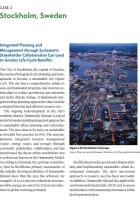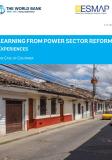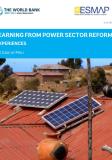Publications

The City of Stockholm, the capital of Sweden, has pursued integrated city planning and management to become a sustainable city (figure 3.20). The city has a comprehensive urban vision, environmental programs, and concrete action plans to reduce greenhouse gas emissions and tackle climate change. It implements integrated urban planning approaches that consider ecological benefits and efficient resource use.
The ongoing redevelopment in the city’s southern district, Hammarby Sjöstad, is a good model for understanding integrated approaches to sustainable urban planning and redevelopment. The area aims to be twice as sustainable as Swedish best practice in 1995. The area implements integrated resource management (waste, energy, water, and sewage) through systematic stakeholder collaboration and has transformed the linear urban metabolism into a cyclical one known as the Hammarby Model.
According to Grontmij AB, a private consultancy firm in Stockholm, primary assessments of the initially developed districts of Hammarby Sjöstad show that the area has achieved, for example, 28 to 42 percent reductions in nonrenewable energy use and 29 to 37 percent reductions in global warming potential.
Eco2 Cities: Ecological Cities as Economic Cities
RELATED:
Part three consists of the Field Reference Guide. The guide contains background literature designed to support cities in developing more in-depth insight and fluency with the issues at two levels. It provides a city-by-city and sector-by-sector lens on urban infrastructure. The next section comprises a series of sector notes, each of which explores sector-specific issues in urban development.
Suzuki, Hiroaki; Dastur, Arish; Moffatt, Sebastian; Yabuki, Nanae; Maruyama, Hinako. 2010. "The Field Reference Guide, Case 2: Stockholm, Sweden." In Eco2 Cities: Ecological Cities as Economic Cities. World Bank. © World Bank. https://openknowledge.worldbank.org/handle/10986/2453


